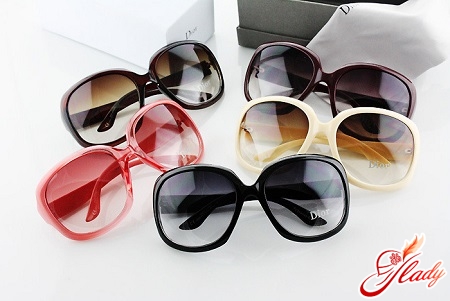 Sunglasses are a must-have for anyoneself-respecting lady. This is a stylish accessory with a huge number of undeniable advantages. When we choose sunglasses, first of all, we pay attention to fashion trends and the appearance of the product. Not many people understand that a stylish frame or purple lenses are not the main points when choosing glasses. Let's consider the main practical recommendations that it is advisable to follow when choosing sun protection accessories.
Sunglasses are a must-have for anyoneself-respecting lady. This is a stylish accessory with a huge number of undeniable advantages. When we choose sunglasses, first of all, we pay attention to fashion trends and the appearance of the product. Not many people understand that a stylish frame or purple lenses are not the main points when choosing glasses. Let's consider the main practical recommendations that it is advisable to follow when choosing sun protection accessories.
Choose the right glasses: the basic steps
- "0" - lenses transmit light by 79-100%, they provide minimal protection from the sun's rays.
- "1", "2" - light transmission is 45-79 or 18-45%. This model is an excellent option for urban conditions and everyday wear.
- "3" - the lens transmits rays by 7-20%. These glasses are well suited for the beach season and recreation outside the city.
- "4" - the light transmission of lenses is 3-7%. This filter is considered the darkest, it protects the retina well in excessively hot sunny countries and in highlands.
Glasses of the last two categories provide the highest quality protection from the effects of infrared and ultraviolet rays.
Lenses: what are they?
Most often, sunglasses are produced withregular lenses of all possible colors. But over time, examples with "fancy" coatings began to appear. Very often, customers do not quite understand the meaning of the concepts: lenses with "photochromic" or "polarizing" coating. Let's figure out what's what.
- Polarization coating
This coating protects against blinding glare andimproves contrast. Glasses with such lenses are ideal for motorists. To check whether the proposed model has a polarizing coating, it is enough to use the services of an optics store, where you can see an image on a special screen or sticker that is invisible to the naked eye.
- Anti-glare (antireflection) coating
Removes ghost images and glarethe back surface of the glass. What does this mean? It happens that we see a reflection of our eyes or objects located behind us inside our glasses. "Parasitic images" significantly worsen the clarity of vision, especially when driving a car at night. This coating eliminates this problem.
- Photochromic coating
Such lenses are also called chameleons, becauseThey change color (lighten or darken) depending on the lighting. Models with photochromic coating are very convenient for people who have vision problems but do not want to change glasses over and over again when entering a room or walking outside.
- Mirror Coating
These lenses are darker than the regular version.They deflect heat rays and are recommended for skiing or swimming. And a couple more points. If you put on your favorite glasses with colored lenses, and the world instantly changed color, know that you are looking at a real fake. Branded lenses correctly convey colors, only slightly changing their shade. Violation of the usual color range in favor of one of the colors greatly distracts attention and tires the eyes. In addition, accurate color perception is very important for some categories of people, for example, motorists, so colored lenses are not suitable in all situations. The most optimal are gray (from light shades to deep) and brown. Gray provides a clear real perception, and brown - contrast. Drivers are recommended to choose yellow, this filter does not strain the eyes and helps to better perceive space. Orange lenses reduce the blinding effect of light in the dark, and green ones add contrast to the environment in the absence of sufficient light, and also protect from bright rays. Avoid lenses that make the world appear purple or blue (literally). In such glasses, you risk losing your sight in almost one summer. The predominance of blue and violet parts of the spectrum slows down motor skills and the rate of human thinking, and blue-light blue increases the effects of light scattering, which causes the risk of glare, for example, from the headlights of oncoming cars.
Glass or plastic?
Sunglasses lenses are made from three materialsmaterials: glass, acrylic and polycarbonate plastic. Glass glasses are the safest option, as they do not transmit ultraviolet rays. But over time, plastic has gradually replaced glass, as it is more practical and lighter. Glasses with plastic lenses transmit ultraviolet light, and the darkening deceives the eyes, due to which the pupil expands and takes all the negative solar wave on itself. Over time, such an effect can lead to weakening of vision and clouding of the lens. It is advisable to buy plastic glasses with additives that help to retain radiation. When buying, pay attention to the label, the most harmful rays are type B, so the products should protect against them almost completely. In addition, if the label mentions the cutoff wavelength, it is better to give preference to glasses with a value of about 400 nm.
Choose a frame
The most practical material for manufacturingframes have always been considered nylon. It bends well and can return to its original position. As for plastic, such frames break quickly, so it is better if there is also a metal frame inside the plastic frame. When choosing glasses, pay attention to the quality of the frame itself. Open the temples a couple of times, bend them. A good frame should be elastic and not rigid. Check the screws that attach the temples, are they screwed on well. And finally, try on the glasses. Are they comfortable, do the temples pinch, do they press on the bridge of the nose? If you tilt your head, the glasses should not slide down to the tip of the nose or fall off at all. By the way, if the frame is initially rigid and uncomfortable, it will remain so, do not hope that the glasses will "break in".
Which glasses are suitable for different types of face?
When we think about the question:"How to choose sunglasses?", we weigh all the pros and cons, choose a brand and model, and inevitably think about which option will suit my face type. Surely, you have had a situation when there is just an ideal model on the display case, but it doesn't suit you and that's it. Let's figure it out.
- Oval face
A universal type that suits absolutely any shape of glasses. And to avoid disproportion, the width of the product should be the same as the widest part of the face.
- Round face
This type is contraindicated in glasses with lenses inoval-shaped glasses, as they will make the face look even rounder. In this case, it is better to give preference to rectangular shapes or a cat's eye version. As for the frame, glasses with a thin rim or no frame at all will look good.
- Square face
Here, on the contrary, glasses of oval shape or with a rounded frame are ideal. It is advisable not to choose rectangular models, so as not to sharpen the corners even more.
- Stretched out (long) face
In this case, the task is not to lengthen the face, but to visually make it smaller. Glasses that are elongated in width or have a wide frame will help you with this.
- Triangular face (heart)
To soften pronounced cheekbones, it is better to choose frameless glasses of an oval or round shape.
Read the label
As with any other product, sunscreensThe glasses come with a label. How can you tell what it says? If you see an inscription, for example, "blocks at least 95% UVB and 60% UVA", this means that the glasses block 60% of ultraviolet rays of type A and 95% of type B, i.e. the product protects against the two most harmful types of radiation. The inscription "plastic" means that the product is made of plastic. Pay attention to the name of the company, the country of manufacture. And to check whether the glasses are genuine, you can compare the brand name on the lens or the inside of the temple with the name on the label. In addition, each brand releases its products in branded boxes.
How to care for sunglasses
To ensure that your purchase lasts a long time,Store it properly. You can buy a semi-rigid case or a hard case. Do not place your glasses on a table or any other surface with the lenses facing down, as they can easily get dirty and scratched. Do not forget to wipe the lenses with a thin chamois or lint-free cloth. These materials very gently clean the lenses from dirt. Regardless of the degree of darkening of the lenses, it is not recommended to look at the sun, and if the skin around the eyes still gets tanned when wearing glasses, this is a sign that they need to be changed. Sunglasses should not only be a beautiful accessory, but also good protection from radiation.









